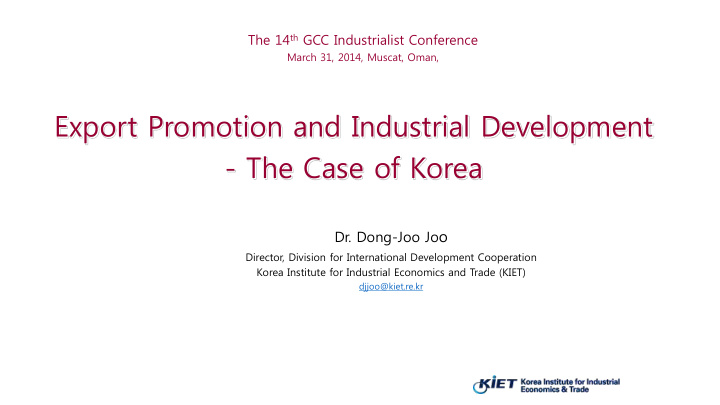



The 14 th GCC Industrialist Conference March 31, 2014, Muscat, Oman, Export Promotion and Industrial Development - The Case of Korea Dr. Dong-Joo Jo o Director, Division for International Development Cooperation Korea Institute for Industrial Economics and Trade (KIET) djjoo@kiet.re.kr
Korea’s economic growth based on Export drive – from a poor country to a globally leading industrial producer GDP Per Capita ($, nominal) 1960 (A) 1965 1970 1980 1990 2000 2005 2005 2013 (B) B/A 87 87 130 270 1,810 6,000 9,790 15,830 830 26,305 302 Exports ($billion, current) : the World’s 6 th as of 2013 1960(A) 1970 1980 1990 2000 2005 2013(B) B/A 0.1 1.2 20.5 73.7 209.0 284,7 557.3 46,441
Changes of Korea’s Industrial Policies 1 . Import Substitution (before 1960) 2 . Promoting Export-oriented Light Industry (1961-1972) 3 . Promoting Heavy-Chemical Industry (1973-1979) 4 . Industrial Rationalization (1980-1990) 5 . Promoting High-Tech Industry (1987-1990s) 6 . Exploring New Growth Engine Industries (2000s ~ Present) - 3 -
Government Intervention for Export Drive during the Early Industrialization Period (1960s-70s) Korea turned to Export Drive responding to the shortages of foreign currency resulting from the decrease of Foreign Aid, mainly from the US, since the early 1960s Export Target Each Year and Strong Drive Incentives and Awards Establishment of KOTRA (1962) Provided overseas market information and assistance to exporting SMEs Role of KITA not just as the Conventional Trader’s Society but as an Instrument to promote exports - Membership fee was obligatory (semi-tax) Establishment of Total Trading Companies by the Trade Law To function as the windows (agency) for exports of SMEs - 4 -
Government Intervention for Export Drive The Expanded Meeting for Export Promotion Presided by the President and attended by the Ministers and Entrepreneurs - 5 -
Major Tools of Export Promotion Policies during the Early Export Drive Period (1960s-70s) Systemic Assistance (incentives) to Exporters Allowance for retaining foreign exchange earnings and Preferential Exchange rates Exemption from import controls and tariffs Financial support for exporters at preferential interest rates Tax concessions and favor for key industrial firms National Awards by the President Manpower Training Establishment of vocational schools at various levels (high schools, colleges, universities) Establishment of Trade Department in Major Universities Establishment of Foreign language training center - 6 -
Continued Industrial Upgrading and Catch-Up Korea’s exports have grown very fast, which provoked severe challenges from inside and • outside Due to the rise of income, labor-intensive low price goods lost competitiveness • Advanced countries have introduced protective measures • Korean government and business sectors have promptly responded to the new challenges and tried to • explore new sources of competitiveness Industrial upgrading has been the key to continued growth of exports and the whole economy • Changes in Major Industries and Policy Priority Sectors Labor-Intensive Capital-Intensive Technology-Intensive (textiles, footwear) (shipbuilding, steel) (automobile, semiconductor) - 7 -
5 Leading Export Items of Korea by Year 1961 1970 1980 1990 2000 2005 2010 iron ore textile clothing clothing semiconductor semiconductor ship tungsten multi-tube steel plate semiconductor computer automobiles semiconductor raw-silk wig footwear footwear automobiles portable phone display video petroleum anthracite iron ore ship ship automobiles equipment products audio petroleum squid electronics ship Ship petrochemicals equipment products 8
New Challenges and Changing Policies Increase of Income and Improved Standard of Life Increase of Labor Cost and Rent Production Automation and Outward FDI Changes of Life style and Labor attitude in parallel with Upgraded Education level Imports of foreign labor Private sector-led industrial structure and Democratization Direct government intervention difficult Intensified Competition in the Global Market Innovation and Technology driven new products as imperative Increase of R&D WTO regulations and New Global Standards Direct subsidies and financial assistance impossible Insurance, export credit, project financing expanded
Industrial Vision and Strategy From a Fast Follower to Global Leader From Learning (Catch-up) to Innovation and Creation Technology and Knowledge-based Competitiveness : Importance of R&D and “Creative Economy” Open and Strong Industrial State Active Participation in FTAs and Global networks The only country so far that concluded FTAs with EU and USA Respect for Global Standard and Regulation Knowledge Sharing for Developing Countries Significant increase of Foreign Aid (ODA) donation
Industry 2000 2010 2015 2020 1 1 Shipbuilding 1 1 1 1 Digital TV - 1 1 1 Display 2 1 5 5 Petrochemicals 4 6 5 4 Automobile 5 4 6 6 Iron and steel 6 6 2 1 Communication Equipment 5 1 3 2 Semiconductor 3 2 8 General Electronics 12 7 6 14 Aerospace 20 10 7 Source : KIET 11
Factors accounting for the Economic success Export-oriented industrialization policies Developmental State with Market Orientation: Strong leadership and capable Bureaucrats Success-motivated Business class Role of Indigenous Think-Tanks: KIST (1966), KDI (1971), KIET (1976) Diligent People and Education Fever External Factors: ODA during the initial take-off stage 2014-04-17 12
Korea’s case and Implications for GCC Different Initial Setting and Comparative Advantages GCC with Rich Energy Resources and Capital – downstream and forward industries have the potential Korea with abundant cheap labor in the beginning and the technology oriented manpower later Continuous Industrial Upgrading and Exploration of New Source of Competitiveness Essential for sustainable industrial development and economic growth Manpower Training is most important
GCC and Korea : Promising Partners Korea and GCC have quite different economic structures, which can complement each other’s strength and weaknesses Korea GCC • Strong Industrial Basis • World’s largest energy resources • Experiences of Industrial Development • Enough Financial Resources (SWFs) Strength • Technology and Manpower - Globally • Geographical Advantage as a Nexus competitive enterprises to Europe & Africa • Energy & Raw Material Dependence on • Heavy Dependence on Energy Sector Weakness Imports • Constant Innovation and Upgrade of • Industrial Diversification Tasks Industries
مكعامتسا ىلع اركش Thank You!! djjoo@kiet.re.kr
Recommend
More recommend